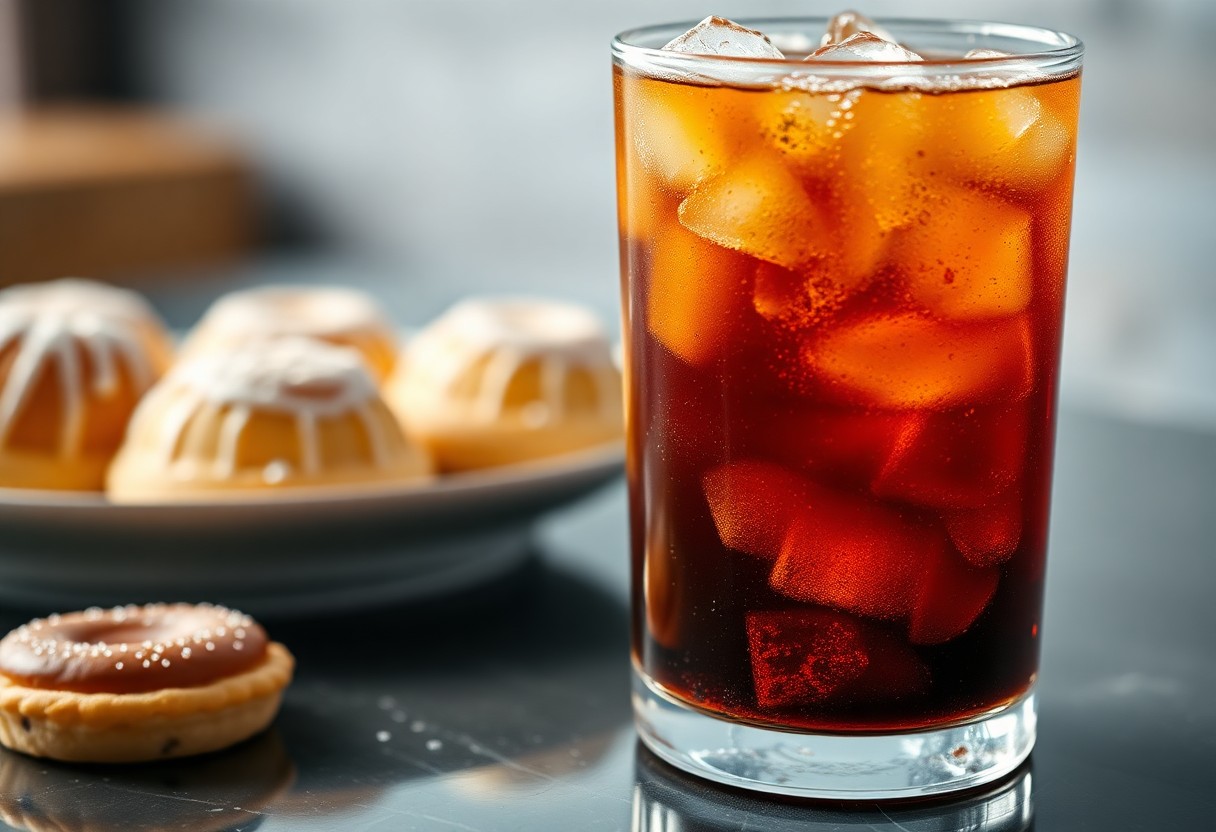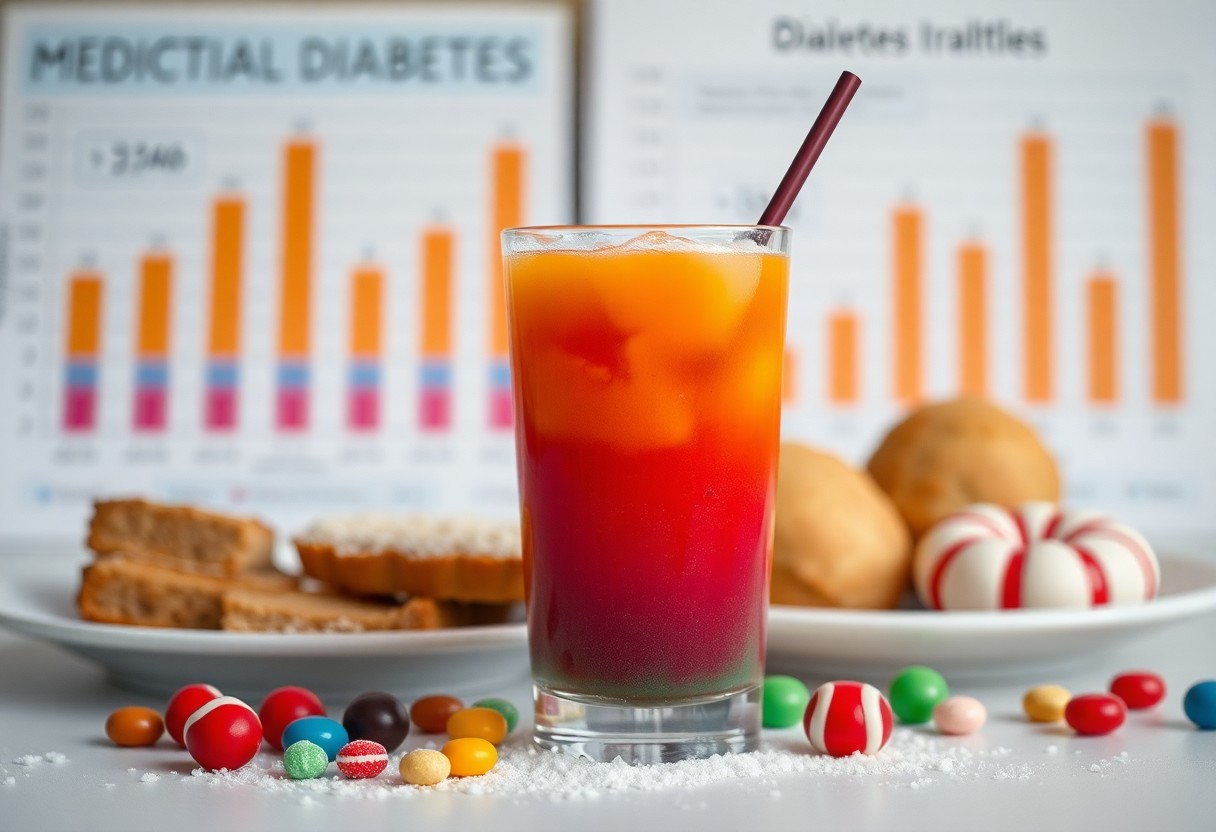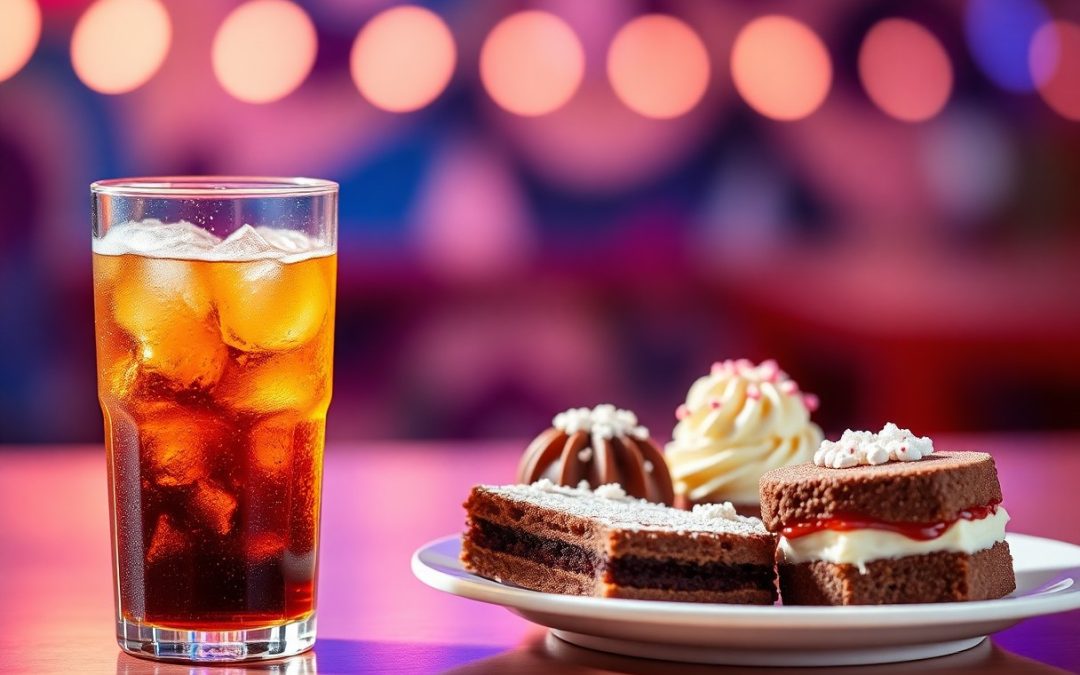Just by choosing what you drink, you can significantly influence your health. Research shows that consuming sugary drinks like soda and fruit juice raises your risk of type 2 diabetes more than eating sweet foods. This is because liquids cause rapid sugar absorption, leading to sharp blood glucose spikes and increased insulin resistance. In contrast, sugars in foods are absorbed slower due to fat and protein content, which helps protect your health. Making informed drink choices is a powerful step to safeguard your well-being.
The Alarming Link Between Soda Consumption and Diabetes
Drinking soda daily significantly elevates your risk of developing type 2 diabetes. Across 29 long-term studies involving over 500,000 adults worldwide, a consistent pattern emerged: consuming just one soda per day raises your relative risk of diabetes by 25 percent. This risk persists even after adjusting for factors like BMI, calorie intake, and lifestyle habits. The rapid absorption of sugars in these beverages triggers sharp blood glucose spikes, stressing your liver and insulin response over time, setting the stage for metabolic dysfunction.
Analyzing the Meta-Analysis Findings
The comprehensive meta-analysis tracked sugar consumption through participant surveys over multiple years, focusing on both total sugar and types such as sucrose and fructose. Importantly, the studies were prospective and observational, following people’s real-life eating habits without intervention. This approach revealed a meaningful association between sugary drink intake and elevated diabetes risk while controlling for confounders like physical activity and family history. The consistency across diverse populations strengthens the reliability of these findings.
Relative vs. Absolute Risk Explained
The reported 25 percent increased risk from daily soda represents a relative, not absolute, change. If your baseline chance of diabetes sits around 10 percent, consuming four sodas daily could double that to a roughly 20 percent absolute risk—an impactful increase that translates risk ratios into concrete personal stakes.
Understanding the difference between relative and absolute risk can reshape how you view health advice. Relative risk shows how much more likely an event is compared to another group, but absolute risk quantifies your actual likelihood. So, while a 25 percent relative increase sounds concerning, knowing it can potentially double your baseline risk puts that number into perspective. This helps you weigh decisions, such as cutting back on sugary drinks, against your personal diabetes risk profile.
How Liquid Sugars Impact Metabolism
Liquid sugars accelerate blood glucose and insulin spikes because they enter your bloodstream almost immediately after consumption. Without fiber, fat, or protein to slow absorption, your liver faces an overwhelming influx, especially from fructose-rich drinks like soda. This rapid delivery challenges your metabolic system, promoting fat buildup in the liver and disrupting insulin signaling. Over time, such stress can increase insulin resistance and elevate your risk of developing type 2 diabetes, underscoring why drinking sugars impacts your health more detrimentally than eating them.
The Rapid Absorption Dilemma
Sugary drinks flood your bloodstream with glucose far faster than solid foods do. The absence of digestion-slowing elements like protein or fiber means these sugars cause sharp, sudden spikes in blood sugar followed by intense insulin responses. Such fluctuations strain pancreatic function and your metabolic system, increasing your susceptibility to insulin resistance and long-term metabolic dysfunction.
Fructose and Insulin Resistance Dynamics
Your liver primarily metabolizes fructose, but when confronted with large doses from sweetened beverages, it switches to fat production through de novo lipogenesis. This process leads to fat accumulation within the liver, which interferes with insulin’s ability to regulate blood sugar effectively, thereby raising your risk for insulin resistance and type 2 diabetes.
Diving deeper, excessive fructose from sugary drinks overwhelms normal hepatic energy pathways. Studies show that this diversion to fat production contributes to non-alcoholic fatty liver disease (NAFLD), which correlates strongly with impaired insulin signaling. For instance, a study involving over 500,000 adults demonstrated that those consuming high-fructose corn syrup–sweetened beverages daily increased their relative risk of type 2 diabetes by 25%, highlighting how this metabolic disruption isn’t just theoretical but a real-world concern impacting your health.

Sweet Foods vs. Sugary Beverages: The Processing Difference
The way your body handles sugar differs significantly depending on whether it comes from solid foods or drinks. Sugary beverages, like soda and fruit juice, deliver sugar rapidly and in large doses, causing abrupt spikes in blood glucose and insulin. In contrast, sweet foods often contain fat, protein, or fiber, which slow the digestion process and moderate blood sugar responses. This processing difference explains why sugary drinks pose a greater risk for type 2 diabetes than sweet foods, even when the total sugar content is similar.
How Composition Alters Blood Sugar Responses
Sugary drinks provide sugar in a liquid form that your body absorbs quickly, leading to rapid increases in blood glucose. Meanwhile, sweet foods with fats, proteins, or fiber slow carbohydrate digestion, blunting these spikes. For example, eating an apple with peanut butter causes a slower, steadier rise in blood sugar compared to drinking apple juice alone. This slower absorption reduces stress on your insulin system and lowers long-term diabetes risk.
The Role of Fiber, Protein, and Fats in Digestion
Fiber, protein, and fats all slow stomach emptying and carbohydrate absorption, which dampens blood sugar spikes. Their presence creates a more gradual release of sugar into your bloodstream, helping maintain better insulin sensitivity over time. In contrast, sugary drinks lack these components, resulting in a quick flood of glucose that your body struggles to manage.
Fiber slows digestion by forming a gel-like substance in the gut, physically slowing glucose absorption. Protein stimulates insulin release through amino acids while also delaying gastric emptying. Fats further reduce stomach emptying rates and promote satiety, indirectly controlling glucose levels. Together, they create a buffering effect that sugary beverages cannot provide, explaining why consuming sugar within whole foods is typically less harmful to your health than ingesting it in liquid form.

Strategies for Reducing Sugary Drink Consumption
Cutting back on sugary drinks starts with small, manageable changes. Replacing soda or juice with water or unsweetened beverages can significantly lower your added sugar intake. You might also explore flavored sparkling waters or herbal teas to curb cravings without the sugar spike. Tracking how often you consume sweetened drinks and setting specific goals for reduction can help you gradually shift habits while supporting your overall health. Consider prepping drinks at home to control ingredients and avoid hidden sugars found in many commercial beverages.
The Case for Water and Natural Alternatives
Water remains the best choice for hydration, offering zero calories and no sugar to disrupt your blood glucose. If plain water feels boring, infuse it with slices of citrus, cucumber, or fresh herbs like mint for natural flavor without added sugars. Switching to sparkling water or unsweetened herbal teas can satisfy your taste preferences while avoiding the sharp insulin spikes caused by sweetened drinks. These natural alternatives support your health by keeping sugar intake low and hydration high.
Meal Pairing: Can It Mitigate Risks?
Eating meals rich in protein and healthy fats while drinking sugary beverages can slow sugar absorption and blunt blood sugar spikes, reducing immediate insulin demands. However, even with food, sugary drinks still contribute to a higher long-term risk of type 2 diabetes. Therefore, pairing sugary drinks with meals doesn’t fully neutralize their metabolic impact, though it may buffer acute glycemic responses.
Beyond slowing stomach emptying, protein and fat stimulate insulin secretion and enhance glucose disposal, which can moderate the glycemic effects of sugary drinks consumed alongside food. Despite this, regular intake of sweetened beverages continues to promote liver fat accumulation and insulin resistance over time, regardless of meal pairing. You’ll benefit more by prioritizing water or minimally processed beverages and reserving sugary drinks for occasional indulgence rather than a dietary staple.
Rethinking Sugar in the Modern Diet
You can see sugar isn’t inherently harmful—its impact depends greatly on the form and context in which you consume it. The modern diet bombards you with highly processed sugars, often in liquid form, rapidly elevating blood glucose and insulin levels. Unlike sugars naturally found in whole foods, these isolated sugars lack the fiber, protein, and fat that help regulate their absorption and mitigate metabolic disruption. Shifting your focus away from total sugar quantity toward its source and format can make a significant difference in managing your diabetes risk.
The Benefits of Minimally Processed Foods
Choosing minimally processed foods means getting sugar alongside beneficial nutrients like fiber, protein, and fat that slow digestion. This combination prevents sharp sugar spikes, helping maintain more stable blood glucose levels. Whole fruits, for example, deliver fructose with fiber and antioxidants, which blunt glycemic excursions. Foods in their natural state support your body’s metabolic balance better than isolated sugars, making it easier for you to keep insulin resistance at bay and lower your chance of developing type 2 diabetes.
Understanding the Evolution of Sugar Consumption
You should consider that sugar has been part of human diets for thousands of years, mostly consumed through natural sources such as fruits, honey, and dairy. What’s changed is the rise of industrially processed sugars, especially in sweetened beverages, delivering concentrated doses of fructose far exceeding historical intake. This shift has created metabolic strain, overwhelming liver function and promoting fat production that disrupts insulin signaling, increasing diabetes risk.
Historically, sugar’s presence in diets was moderate and accompanied by fibers, vitamins, and minerals found in whole foods. For example, early human diets included honey and seasonal fruits, resulting in episodic, lower sugar exposure. In contrast, today’s average American consumes over 70 grams of added sugars daily, much from sodas and sweetened drinks alone. High-fructose corn syrup and refined sucrose flood your system, taxing liver metabolism and fueling de novo lipogenesis—the process that converts excess fructose into harmful liver fat. This metabolic overload explains why modern sugar consumption patterns substantially elevate your risk of insulin resistance and type 2 diabetes compared to traditional diets.
Final Words
On the whole, you should be aware that sugary drinks raise your diabetes risk more than sweet foods due to their rapid sugar absorption and lack of fiber, fat, or protein to slow glucose spikes. Consuming these beverages regularly can disrupt your liver metabolism and increase insulin resistance, negatively impacting your health. To protect your health, it’s best to limit sugary drinks and choose whole foods where sugar is naturally paired with beneficial nutrients.
FAQ
Q: Why do sugary drinks raise diabetes risk more than sweet foods?
A: Sugary drinks lead to a faster absorption of sugar because they lack fiber, protein, and fat, which normally slow down sugar absorption. This rapid uptake causes sharp spikes in blood glucose and insulin levels. Over time, these spikes can disrupt liver metabolism and increase insulin resistance, key factors in the development of type 2 diabetes. In contrast, sweet foods often contain protein or fat, which slows digestion and helps moderate blood sugar levels, reducing the overall impact on diabetes risk. Learn more about health and nutrition here.
Q: Can drinking sugary beverages with a meal lower the risk of diabetes?
A: Consuming sugary drinks alongside a meal that contains protein or fat may blunt the sugar spike by slowing digestion and carbohydrate absorption. However, even when eaten with food, sugary drinks are still linked to an increased long-term risk of type 2 diabetes. Experts suggest it is better to limit or avoid sugary drinks altogether and choose water or naturally flavored beverages for better health outcomes.
Q: What is the best way to reduce diabetes risk related to sugar consumption?
A: The safest approach is to focus on the form and context of sugar intake rather than only the amount. Avoid sugary drinks like soda, energy drinks, and fruit juices, which provide sugar in liquid form without beneficial nutrients. Instead, prioritize consuming sugar in minimally processed foods, such as whole fruits, where fiber, vitamins, and minerals help reduce the negative effects on blood sugar and overall health. Hydrating with water or drinks infused with fruit or herbs can also support better health.


